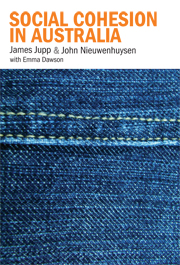Introduction
Published online by Cambridge University Press: 22 September 2009
Summary
There are many features of a society that can undermine its cohesiveness. These include the distribution of income, wealth, employment and opportunity, as well as access to services, voting rights or citizenship among various segments of the population. This book is, however, concerned with one principal question: how can Australia, with its considerable cultural diversity and continuing high (permanent and temporary) immigrant intake, remain socially cohesive? The volume is by no means encyclopaedic. But it covers, with contributions by 16 authors, an important series of aspects of several of the perceived indicators of social cohesiveness in Australia.
Part I surveys the historical quest for harmony in Australia, and the conditions and possible means of measuring social cohesion, as well as current federal government initiatives to attain it. The chapters in Part II consider the landmark of Cronulla; ethnically based youth groups; religious resurgence and diversity; Indigenous Australia, and aspects of cultural fragility; and educational attainment and inter-ethnic marriage. Part III covers unions and the workplace; education; the media; sport; terrorism and politics; and human rights.
The book concentrates on immigration, which has been a central part of Australia's history since first European settlement in 1788. It has been at the heart of the creation of a dynamic society and has helped economic growth. Much of immigration's success has depended on the absence of marked social conflict and division through the arrival from overseas, in peaks and troughs, of so many millions of people from extremely diverse backgrounds.
- Type
- Chapter
- Information
- Social Cohesion in Australia , pp. 1 - 6Publisher: Cambridge University PressPrint publication year: 2007
- 1
- Cited by



